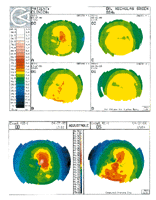Corneal distortion seen in topography of soft contact lens wearers
MISSION VIEJO, Calif. — An optometrist here who routinely uses topography to augment contact lens fitting in rigid gas-permeable (RGP) patients discovered corneal distortion in the corneal maps of his soft lens wearers.
 ---Extreme corneal peak: Corneal topography revealed this corneal peak in a 22-year-old computer programmer and soft contact lens wearer. After being refit in rigid gas-permeable lenses, the peak disappeared and the patient's vision improved. (Link on thumbnail to larger image)
---Extreme corneal peak: Corneal topography revealed this corneal peak in a 22-year-old computer programmer and soft contact lens wearer. After being refit in rigid gas-permeable lenses, the peak disappeared and the patient's vision improved. (Link on thumbnail to larger image)
"I had the same attitude everyone else did: that soft lenses are inert and don't influence the cornea," said Nicholas Green, OD. "But the soft lens is much more insidious than people realize and I never would have believed it if I hadn't seen it myself. We began to notice mild to extreme corneal distortion among 20- to 30-year-old myopes who were engaged in near point activities for many hours."
Green noticed the distortion after he started using topography on soft lens patients who wanted to switch to RGP lenses for orthokeratology, or upon the removal of soft lenses for a general eye health examination. He said the distortion is not a typical keratoconus type; it is usually bilateral and central, yet not the same in each eye.
 --- Nicholas Green, OD
--- Nicholas Green, OD
"We would take an initial picture with the topographer and see these incredible peaks," he said. "If we had just used a regular keratometer on these patients we never would have known the distortion was present."
Green decided to use topography on all his soft contact lens patients, something he had not been doing routinely, and he began to see corneal peaks in many of these patients.
Central peak stranded
"Everyone knew that the soft lenses flexed and they called it a tear pump action," Green said. "But when this tear pump occurs and the cornea cannot come back as it's supposed to, it leaves the central peak stranded."
 --- Philip M. Buscemi, OD
--- Philip M. Buscemi, OD
Philip M. Buscemi, an optometrist from Greensboro, N.C., said he has observed similar corneal distortion among his soft lens patients. Both optometrists use the Tomey corneal topography system.
"I first observed this distortion in a toric soft lens patient who had been wearing the lenses for 2 years instead of changing them every year," Buscemi said. "One eye had slightly reduced acuity, and when we did topography the distortion we observed in the cornea was commensurate with the reduced acuity."
Buscemi refit the patient in toric lenses, brought him back in 2 weeks for topography and observed no corneal distortion. "There was little doubt that the distortion was secondary to protein build-up and probably a combination of an inflammatory response secondary to giant papillary conjunctivitis (GPC) and some reduced oxygen transmissibility to the lens."
Buscemi also observed corneal distortion in a patient who wore disposable lenses, had been sleeping in the lenses and was showing 20/25 correction.
"This was not quite down to 20/20 like we'd expect, so we pulled the lenses and found a significant corneal distortion," he said. "When the patient resumed daily wear, it disappeared."
Buscemi said the common threads are the potential for reduced oxygen transmissibility to the cornea and an inflammatory response.
Try higher dK/l lens
Buscemi said thinner lenses with higher dK/l values have allowed him to resolve the distortion he has observed among some of his soft lens patients.
"The other factor involved is an inflammatory response, specifically, secondary to GPC," he said. "If we have patients in normal, good health without other systemic mitigating factors, wearing lenses a long time, and you see bumps on the lid, you treat short-term with therapeutic agents and have them change the lenses more frequently."
Buscemi said he will often put patients in a CSI therapeutic lens in order to achieve high oxygen transmissibility and reduce the probability of GPC recurrence. Among the new lenses on the market, he favors Proclear from Biocompatibles because it is known to reduce protein adherence to the lens.
Patient education is also important, he said, so that soft contact lens wearers use the proper enzyme solution to clean their lenses.
Switch from soft to RGP
Green said his contact lens practice is now almost a 50-50 split between soft lenses and RGPs, partially as a result of discovering corneal distortion in the soft lens population.
Corneal topography has been key, Green said, both in observing corneal distortion and as a tool for patient education.
"The soft lenses will be the most comfortable, but if I switch patients to RGPs it takes an adaptation period, and I tell them that up front," he said. "The most dramatic tool is the picture from the topographer. It increases patient awareness and often helps them tolerate this adjustment."
Soft lens patients who switch to RGP lenses to resolve corneal distortion will also tolerate a few days of adjustment, Green said, because they notice their vision improving within the first week.
As a result of his discovery, Green advocates routinely using corneal topography for all contact lens patients.
"As optometrists, we are trained that the cornea is the major light-bending part of the eye, but if we don't have the ability to gather the most information possible about the cornea, we're missing the whole picture," he said. "If you're going to be fitting 1990s lenses, you can't rely on 1920s equipment to gather information."
